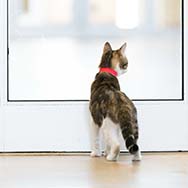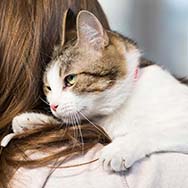Why Does My Cat Always Want to Be Where Hes Nog Allowed
Training Your Cat To Stay Inside
Bringing an outdoor cat indoors can be stressful, here are some tips on making it a successful transition

Most cats who are kept indoors from the start show no inclination to go outdoors. In fact, they may become frightened if they accidentally wander out the door.
But what if your cat is already used to being allowed outside? Transforming a free-roaming cat into a safe cat can be done, but it does require planning, persistence and patience. The key is to make the change from outdoors to indoors gradually, until the new way of life becomes old hat. Many cats will adjust with minimal effort while others will be miserable and let you know it. They may scratch at doors, claw at windows, yowl and try to dash through open doors.
- If your cat has never used a scratching post or a litter box, introduce both items well in advance of transitioning your cat to life inside. If you're feeding your cat outdoors, begin feeding him indoors. Then, instead of letting the cat back outside as soon as he's finished eating, keep him inside for gradually longer periods of time.
- Other members of the household may have to be "retrained" to close doors quickly and provide more stimulation for their feline friend. Playing with the cat is a great way to keep both his mind and body in shape.
- Some former free-roamers will appreciate your providing "kitty greens" for them to munch on instead of your houseplants. Try planting grass, alfalfa, catnip, wheat or oat grass (sold in pet supply stores) in indoor pots for this purpose.
- If you live in a climate that has cold winters, that season may be the perfect time to help your cat make the transition to a life indoors. Your cat is likely to appreciate a warm, dry bed in which to snuggle.

- If you're having trouble slowly transitioning your cat to a happy life indoors, it may be better to go "cold turkey." Letting your cat outdoors occasionally may only reinforce his pestering behaviors. Your veterinarian may prescribe a short-term drug or homeopathic therapy to help your cat through the transition period.
Considering making your indoor cat an outdoor cat?
- If you have an indoor cat who is scratching your couch or not using the litter box, think twice before you put your cat outdoors. Consult your veterinarian to rule out any medical problems that could be contributing to problem behaviors. If your cat gets a clean bill of health, work with your veterinarian, a trainer, or animal behavior specialist who uses positive training techniques. There is always a reason, from your cat's point of view, for behavior that you consider to be inappropriate. He is not acting out of spite or revenge. Patience and persistence, not punishment, are the best way to get your cat back to his good habits.
- If allergies or pregnancy make you think about putting your cat outside or even giving up the cat, consult your physician and learn how to manage those conditions while keeping your cat safe.

By providing for your indoor cat's physical and emotional needs, you can create a safe and stimulating environment. Although domesticated several thousand years ago, cats still retain many behaviors of their wild ancestors. These delightful behaviors can be played out in the great indoors. A paper grocery bag, a cat's vivid imagination, and your caring attitude will go a long way toward keeping you and your cat safe and young at heart.
If you would like to work with a Wisconsin Humane Society behaviorist one-on-one regarding this behavior topic, please call 414-431-6173 or email behavior@wihumane.org to schedule a consultation.
Why Does My Cat Always Want to Be Where Hes Nog Allowed
Source: https://www.wihumane.org/behavior/ask-the-experts/cat-behavior/training-your-cat-to-stay-inside
0 Response to "Why Does My Cat Always Want to Be Where Hes Nog Allowed"
Post a Comment